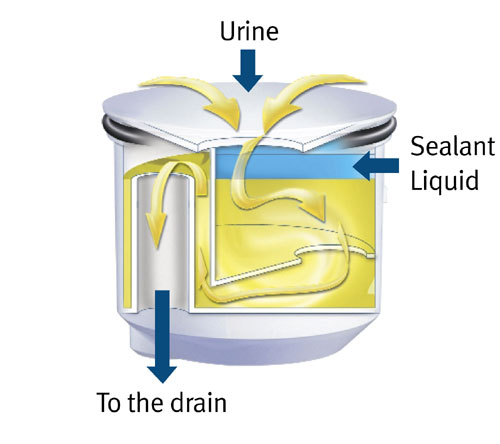Waterless Urinals have a lot of misinformation flying around about the way they operate. Some contractors will tell you that they will save you thousands of litres of water and in turn thousands of dollars. While that may be true it doesn’t mean it’s always the case. Other people may tell you that they stink. In some circumstances that may also be true, however only if those urinals are not being maintained properly. This article has been written to give you a clear idea of what a waterless urinal is, how one works, the benefits of having one installed and the times when a waterless urinal isn’t the best option.
What are Waterless Urinals?
They are the same as your standard flushing urinal, with one main difference: they don’t use water to flush away the urine. Coming on the scene in the early 90’s, Waterless urinals were never that popular. It wasn’t until the turn of the century when the world started to go ‘green’ and think about ways to preserve valuable water resources that waterless urinals started to gain a place in the marketplace.
There was, however, a lot of confusion surrounding the way these flushless urinals work. Many started blaming them for the bad smell in the bathroom despite the smell always having been there; others claimed that they were a health risk – despite evidence showing they were more sanitary than the standard flushing urinal. So how do these urinals work?
How do Waterless Urinals Work?
The urinals utilise an odour-locking device in the base of the urinal bowl to take away urine and its smell without the need for water. This odour-locking device varies in design from a basic odour-locking oil barrier system to more sophisticated mechanical one-way valves.
Once the urine has run through the odour-locking device, gravity does the rest of the work, carrying the urine into your sewer system – just like a flushing urinal.
All of the waterless urinals sold in Australia should have watermark certification. This approval involves each urinal and its associated odour-locking valve being tested to ensure it meets the plumbing codes for Australia.

Why use Waterless Urinals?
For anyone looking to save water, they are a sound choice since they will reduce your water consumption. Apart from the water savings, non-flushing urinals also tend to be a cheaper option for new bathroom installations. Regular flushing urinals often incur substantially higher installation costs than these urinals, for their required pipework and flushing devices.
They also reduce the spread of bacteria. The water that constantly sits on the bowl in a regular flushing urinal presents a perfect environment for bacteria growth, and the flushing of these urinals will often spray this bacteria into the air, causing it to become airborne. These are both issues that waterless urinals avoid.
Where can you get a Waterless Urinal?
The Urinal Shop stocks a wide range of environmentally friendly urinals to suit many different areas – Restaurants, Pubs, Office Buildings, Commercial premises and more. Each unit adheres to Australian Health and Safety regulations and all use the latest waterless technology.
Should Waterless Urinals Smell Bad?
NO!
If this is the case then please feel free to let us know where the bad-smelling urinal is located. We say this because, with more than 10 years of experience in and around waterless urinals, we can confidently state that waterless urinals DO NOT SMELL bad – if they are looked after properly.
Regular Maintenance
Another factor to consider is the cleaning and regular maintenance. If your urinal is being used every day by more than 10 people, then it needs to be cleaned every day.
Regular maintenance of these urinals is critical to their proper operation. This regular urinal service ensures the urinal valve is working properly and the urinal pipework is clear of any foreign matter that may affect its function. The regularity of the service depends directly on the amount of use your waterless urinal has and this cost should be taken into account when you are looking at the long-term viability of a waterless urinal.
Please don’t assume that because we offer urinal cleaning as one of our services, that we are making too big a deal of the necessity for this step. If you don’t do it then your urinal will NOT work long term. Guaranteed.
When not to use Waterless Urinals?
Although waterless urinals are an excellent option for most sites, there are situations where a waterless urinal will not be suitable.
Copper pipework – Waterless urinals are not compatible with copper pipework
Badly designed drainage – Pipework requiring high levels of water flow due to long pipelines (or poor layout) will not work well.
You may not know the answer to these areas yourself but it is worth checking with your plumber before going waterless.



I am doing a cleaning duty at a public facility. The male toilet has a waterless urinal . In my opinion it stinks . Should it be necessary to place anti deodorant blocks in this urinal
I have asked my employer with not being given a satisfactory answers I enquire with you
Hi Wilhelmus, Thanks for your comments. Waterless urinals can become smelly if regular servicing and cleaning is not provided. A service kit/cartridge may need to be replaced depending on what brand waterless urinal you are cleaning. We would be happy to provide the relevant information if you could provide the brand/model of urinal. Scented urinal mats can be used in waterless urinals to help mask odours, provided the regular servicing is done. Feel free to reach out to us on 1800 874 625 or email us at info@theurinalshop.com.au for further information.